Make a meadow, whatever the scale
Become a master of your own meadow. Whether it’s a pot on a balcony, a small patch of garden, a shared community space, or several hundred hectares, you can make it richer in grasses and wildflowers by following these simple steps:
Stop
To make a meadow, you could simply stop cutting your grass so regularly and see what grows. Cut once in summer and again in winter, removing all the cut material each time. If the diversity is not improving after some time, consider adding more species by following the steps below.
Soil
Wildflowers and fine grasses need soil that is low in fertility. Choose an area in your garden that has not had fertiliser, compost or manure added recently, or use compost in pots that is peat-free and low in nutrients. In a garden, topsoil stripping is an option and/or putting down a layer of limestone chippings or gravel. Lime locks up phosphorus and suppresses the big competitors. If you have space for a larger scale, field-based project, have a soil sample tested for fertility. If your soil is high fertility, you need to reduce the fertility by taking repeated hay cuts and removing the material from the site. After about 3 years, your soil should start its fertility cycle and will be ready for seed.
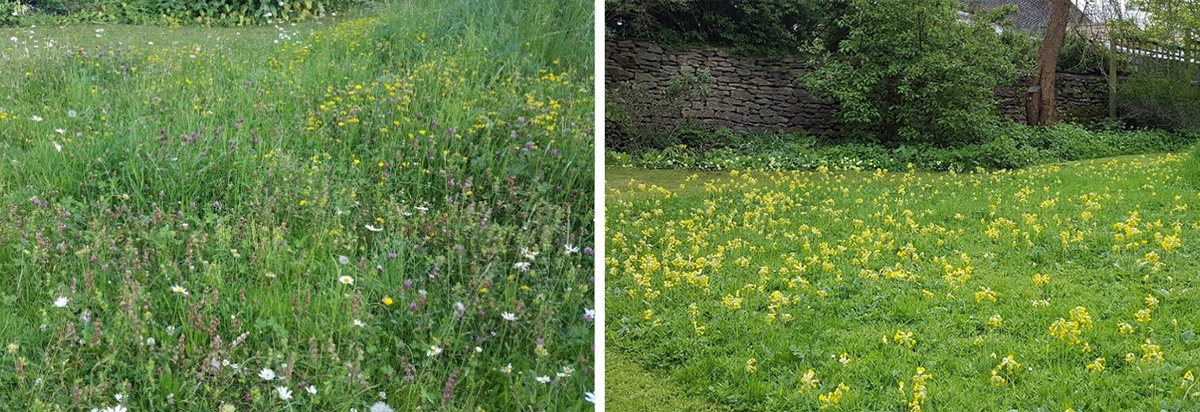 A mini meadow in a private garden.
A mini meadow in a private garden.
Seed
To introduce seed into your meadow, choose native wildflower and grass species. These can be bought from reputable suppliers or talk to your local Wildlife Trust to get advice on seed sourcing (guide here). Before sowing the seed, prepare the ground by removing existing vegetation and creating bare patches, so the seed has space to germinate. Sow the seed when the weather is wet and warm. Autumn (September to November) is the best time of year.
For larger areas, you may be able to source a hay crop from a nearby meadow, which contains a good range of species that can then be spread on your land.
Speed
Be patient. Creating a small wildflower meadow in a pot may happen quite quickly and some species may flower in the first year. However, some wildflower seed takes a year to germinate, and several years before they flower, so you need to wait. Letting plants arrive by natural processes may eventually result in a nice meadow, but it will take several years; you can speed the process up by adding seed or plug plants over time.
Some species will germinate quickly and dominate, others take time. Regular cutting will help the slower species to establish and spread, but it will take time. Repeated application of seed will increase the diversity of your meadow. Watch and enjoy the changes each year, become familiar with the names of the species you bought as seed and plugs, and see what arrives on its own.
Sustain
Let your seeds germinate over winter and grow into the following year. If your soil is rich in nutrients, cut the new growth back to 5 cm in June, again in August, and finally in winter. The cut material can all go on a compost heap. If your soil is poorer, then the timing of the cut is less critical; oncee in summer and once in winter will do. In a pot, get a pair of scissors and trim the plants down to about 5 cm and remove the cut material a couple of times each year.
A key aspect of creating a meadow is removing the material you cut. This stops the nutrients from returning to the soil and boosting the big bully species (like ryegrass or cocksfoot) from outcompeting the others. Even if your meadow is in a pot, it is best to remove the cuttings. For bigger projects, you may be able to find a farmer interested in using your hay as animal feed. This farmer may be happy to perform the hay cut in exchange for the hay produced and may also be interested in grazing the field afterward.
You may get species in the early years that you don’t want in your meadow, for example, docks and thistles. In a small garden or pot, you can pull these up as you spot them. In a larger project, that is more difficult to do. However, these species do not survive for long in a meadow when the hay is cut each year in June. As the various grasses and herbs cover any exposed ground, there will be less and less space for these unwanted plants to take hold. So, in time, they will diminish. Be patient.
Further information:
- Floodplain Meadows Partnership website.
- Wildlife in the city - create your own meadow.
- Magnificent Meadows - mini meadow PDF.
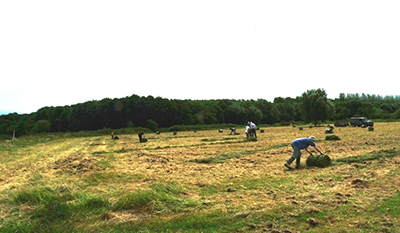 Avon Meadows in Worcestershire, a floodplain meadow. The Friends of Avon Meadows and Wychavon District Council are restoring the plant diversity at this meadow by spreading hay from a nearby species-rich meadow.
Avon Meadows in Worcestershire, a floodplain meadow. The Friends of Avon Meadows and Wychavon District Council are restoring the plant diversity at this meadow by spreading hay from a nearby species-rich meadow.
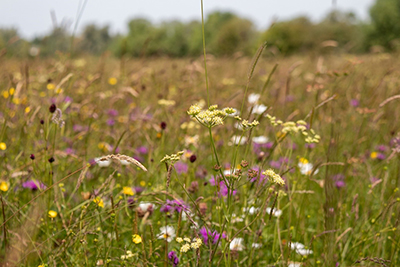 Priors Ham, a floodplain field which was previously grazed most of the year, had seed sown in 2010 and again in 2011. The site is managed by Cricklade Court Leet, a community group.
Priors Ham, a floodplain field which was previously grazed most of the year, had seed sown in 2010 and again in 2011. The site is managed by Cricklade Court Leet, a community group.
The diversity of meadows
A “meadow” is an area of grassland that is cut for hay. Hay has been a key part of European agriculture for thousands of years. It was essential means of storing grass as food to keep farm animals alive through winter. Meadow is distinct from “pasture,” which is grassland on which animals graze during spring and early summer away from the neighbouring meadows full of hay.
There are many types of meadow, each with its own distinctive vegetation. In the UK, the main categories are:
Floodplain meadows
These occur in river valleys on land which floods naturally. They represent the most traditional and the most productive type. In medieval England, the vast majority of floodplain land was devoted to meadows and they were valued more highly than any other type of agricultural land. Their special attribute is the regular delivery of plant nutrients by floodwaters.
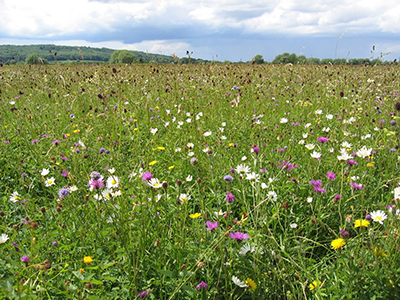 A floodplain meadow in summer. Characteristic species: Great Burnet (Sanguisorba officinalis).
A floodplain meadow in summer. Characteristic species: Great Burnet (Sanguisorba officinalis).
Water meadows
These were cleverly engineered to flood artificially to boost growth and became popular in the 18th century, but have now largely fallen out of use. They were tended by someone called a “drowner” who regulated a complex system of channels and sluices. The time and trouble devoted to producing hay at that time illustrate how valuable the crop was. Only a handful of working water meadows still survive in England on the chalk streams of Hampshire, but similar vegetation exists on the wetlands of the Somerset Levels and the Norfolk Broads.
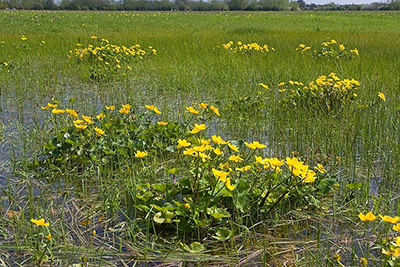 A water meadow in spring, Characteristic species: Marsh Marigold (Caltha palustris).
A water meadow in spring, Characteristic species: Marsh Marigold (Caltha palustris).
Upland meadows
Typical of the Yorkshire dales and the Lake District, these have a later growing season due to being at altitude, but they produce a very rapid burst of growth in Summer. They are typically enclosed by dry stone walling “shut-up” for hay in Spring and Summer but grazed by sheep at other times of the year. They form a key part of the landscape in the Dales
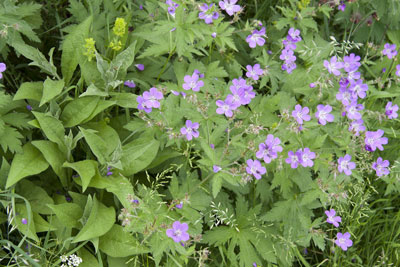 An upland meadow in midsummer. Characteristic species: Wood cranesbill (Geranium sylvaticum).
An upland meadow in midsummer. Characteristic species: Wood cranesbill (Geranium sylvaticum).
Sea-shore meadows
This variety, such as the machair of western Scotland, is where rich grass communities survive on extensive plains of wind-blown shell sand, just a few feet above the high tide level. They were traditionally fertilised with seaweed from the beach just a short distance away. On the Hebrides, they form parts of small landholdings called crofts, which have often been managed using traditional methods for centuries.
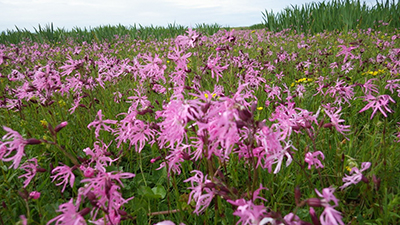 A coastal meadow from the Scottish islands in early summer. Characteristic species: Ragged Robin (Silene flos-cuculi).
A coastal meadow from the Scottish islands in early summer. Characteristic species: Ragged Robin (Silene flos-cuculi).
Dry meadows
These are found on a range of soils across the country where they were traditionally fertilised by spreading farmyard manure or by moving animals from the fertile river valleys, which then delivered nutrients in their dung. Taking hay crops quickly exhausts the soil, so a long-term meadow needs to have an external supply of nutrients. Some fields were used as pasture for much of the time with just an occasional hay crop being taken from it.
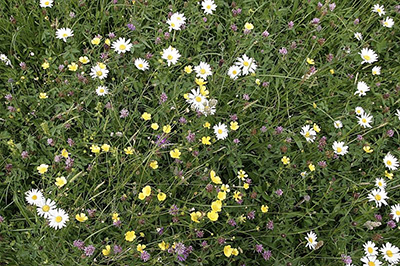 A diverse mix of meadow species. Typical species: Knapweed (Centaura nigra, purple flowers).
A diverse mix of meadow species. Typical species: Knapweed (Centaura nigra, purple flowers).
All of these meadow types, if managed sympathetically over decades or centuries, build up a huge diversity of meadow plants. In any of them, a single-meter square can hold more than thirty different species of plant. The floodplain meadows can even reach forty species. The diversity of plants supports an equally amazing diversity of fungi and insects, which in turn support other wildlife, e.g. birds (skylark, curlew, corncrake), reptiles (grass snakes, common lizard, slow worm), and mammals (roe deer, field vole, hedgehog.)
To learn more about floodplain meadows, visit the Floodplain Meadow Partnership website or continue with other related content on OpenLearn below.
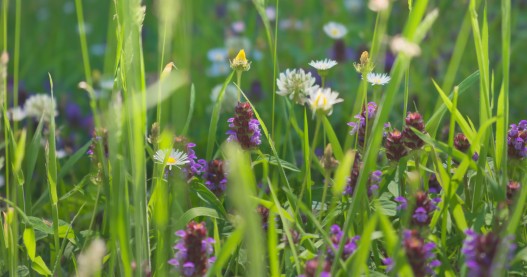

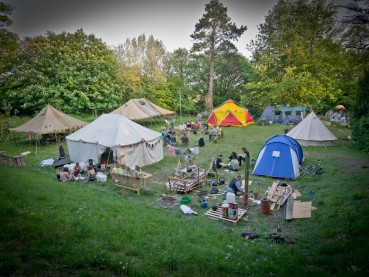
Rate and Review
Rate this article
Review this article
Log into OpenLearn to leave reviews and join in the conversation.
Article reviews